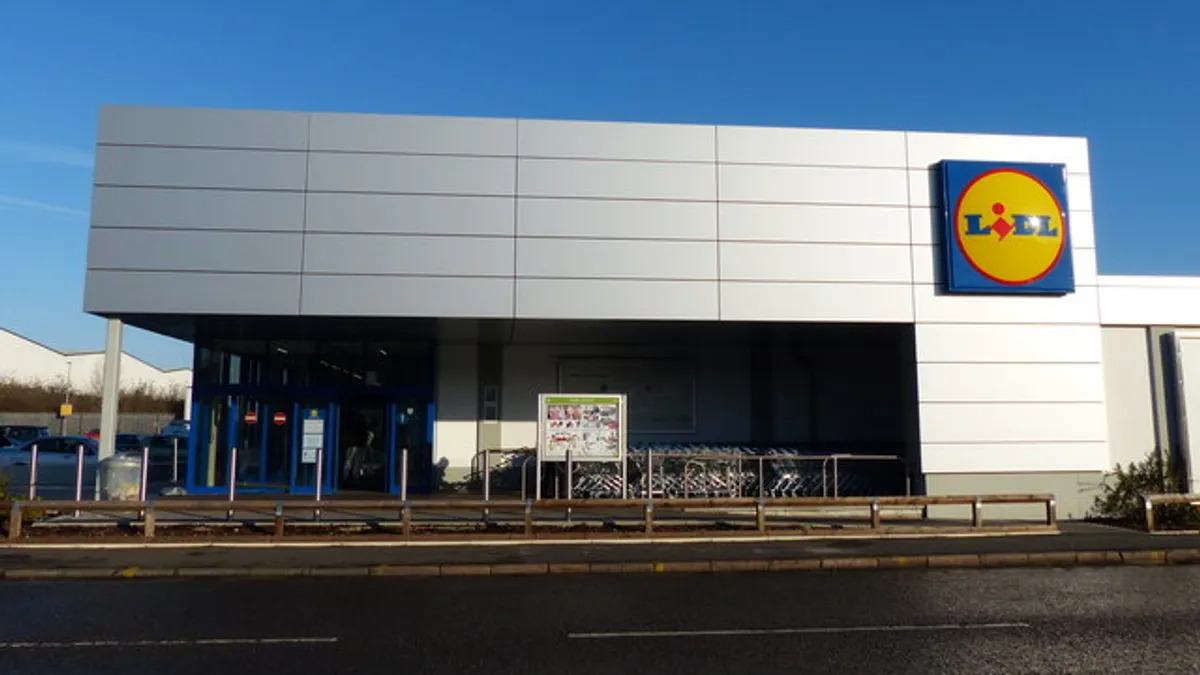Dive Brief:
- Germany-based Lidl may be considering alternative store formats in the U.S., including ground-floor spaces in commercial buildings and previously occupied supermarket spaces in shopping centers and malls, according to Winsight Grocery Business. The retailer has been distributing a brochure in the U.S. that identifies these possible store formats.
- Lidl has opened more than 50 stores in the U.S. since 2017, with most locations being new builds spanning about 36,000 square feet. Reports suggest that this format was unsustainable in some cases and didn't take into account specific criteria unique to each geographic location. Since then the company has sought smaller locations, modified plans for new sites or decided not to pursue others.
- A company spokesman said that although the renderings in the store brochures are not an official announcement for new formats, the brochure indicates what is possible as the German retailer looks for convenient locations for new stores.
Dive Insight:
Lidl has had a rocky start-and-stop pattern since launching in the U.S., beginning with an ambitious opening of 49 stores in 2017 and then dramatically scaling back expansion plans early this year, citing high costs and a lack of understanding of American shopping preferences. Over the course of this year, the momentum has continued to go up and down.
With a move toward new store formats, it seems that Lidl is determined to get it right in the U.S., not necessarily to attract new clientele, but to better understand the needs of the communities it aims to serve and generate a strong customer base, possibly for the first time.
While standalone, 36,000-square-foot stores may be Lidl's preference — or perhaps what it thought U.S. shoppers would prefer — the format does not necessarily work in every U.S. market. As retail evolves and some brick-and-mortar retailers go out of business, large retail spaces will need to be filled. Doing so is more economical than building a new, massive commercial space, especially in light of Lidl's early struggles with costs. Its original U.S. store concept is also challenging if Lidl wants to succeed in urban spaces where land is hard to come by and shoppers may be more accustomed to making smaller, more frequent grocery trips with less square footage to cover.
Despite the hurdles, a recent survey showed that Lidl shoppers are satisfied with the grocer, and those who do shop there seem to be developing a strong loyalty. Discounts, private label brand products and a strong selection of produce, meat, beer and wine seem to be Lidl's high points for customers. While smaller stores may have less selection, the expectation would be that Lidl would still offer a similar product assortment in new stores and focus on offering its best-selling categories.
This isn't the first time news has surfaced that Lidl might consider smaller store formats. Late last year, the retailer announced that it would begin leasing smaller spaces to help it penetrate the East Coast market, which tends to have higher population density and less real estate. Lidl's biggest challenge in this space will be competing grocery stores, given how populated the grocery market is in those regions. These smaller store footprints align more closely with the retailer's approach in Europe, where Lidl is more accustomed to fitting into existing spaces and operating in tighter urban environments.
It's important to keep in mind that Lidl is only in its second official year of operating in the U.S., and as an international brand, it was bound to encounter early challenges and growing pains. Adjusting its strategy to better meet a wider range of U.S. markets, especially if it is easier on the bottom line, is a smart move until there is broader awareness and a stronger track record for Lidl U.S.









